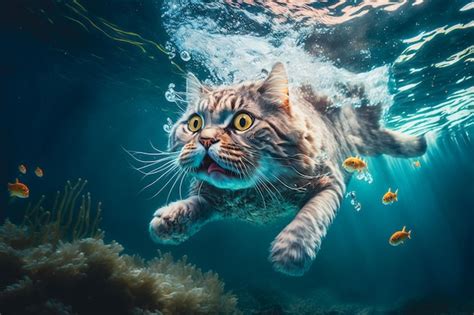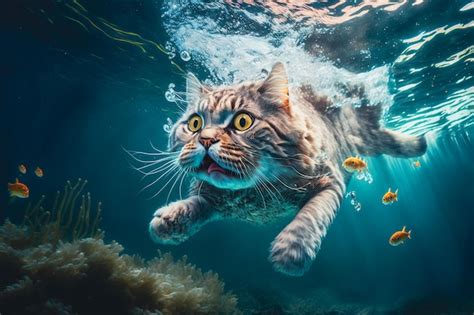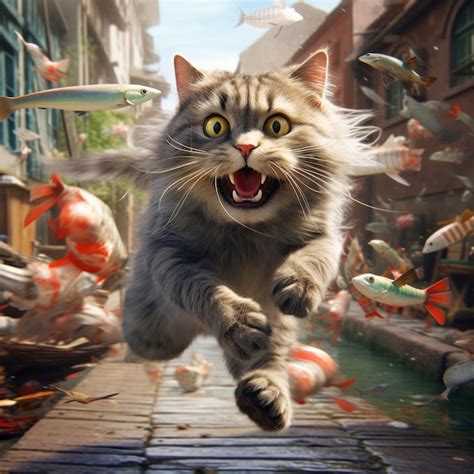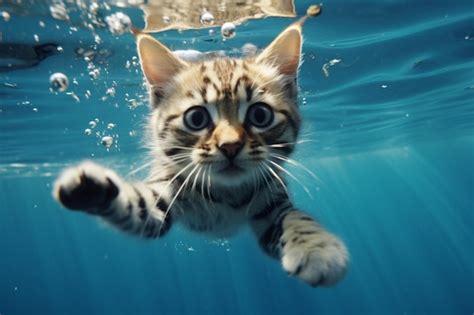
An AI-generated video depicting a cat performing elaborate dives has captivated the internet, sparking both amusement and debate about the realism and ethics of AI-created content. The viral video, showcasing a feline executing flawless flips and dives into a pool, has amassed millions of views and ignited a discussion about the blurring lines between reality and artificial intelligence in online media.
The video, shared across various social media platforms, presents a hyperrealistic scenario of a cat exhibiting athletic prowess typically not associated with the species. The feline’s movements are fluid and precise, complete with perfectly timed entries into the water, leaving many viewers initially believing they were witnessing genuine animal behavior. However, closer inspection and commentary from tech experts have confirmed the video’s artificial origins.
“I didn’t realize cats were doing Olympic diving until now,” one user humorously commented, reflecting the initial surprise and disbelief shared by many viewers, as reported by Yahoo News. This sentiment underscores the effectiveness of the AI in creating a convincing, albeit fabricated, spectacle.
The emergence of such realistic AI-generated content raises several important questions. Firstly, it highlights the rapid advancements in AI technology and its ability to mimic reality with increasing accuracy. Secondly, it prompts a discussion about the potential for misinformation and deception, as viewers may struggle to distinguish between authentic and synthetic media. Finally, it necessitates a broader conversation about the ethical implications of creating and disseminating AI-generated content, especially when it involves animals or other sensitive subjects.
The viral “AI Cat Diving” video serves as a microcosm of the larger challenges and opportunities presented by artificial intelligence in the digital age. While AI offers immense potential for creativity and innovation, it also requires careful consideration of its potential impact on society and the need for responsible development and deployment.
The Anatomy of a Viral Sensation:
The “AI Cat Diving” video’s virality can be attributed to several factors. Firstly, it leverages the inherent appeal of cats, which are consistently popular subjects on the internet. Their quirky behaviors and endearing personalities make them prime candidates for viral content. Secondly, the video’s unexpected premise – a cat performing Olympic-level dives – immediately grabs attention and sparks curiosity. The juxtaposition of a common animal with an uncommon activity creates a sense of novelty and amusement.
Furthermore, the video’s high production quality and realistic animation contribute to its widespread appeal. The AI-generated cat’s movements are remarkably fluid and natural, making it difficult for casual viewers to discern its artificial origins. This realism enhances the video’s entertainment value and contributes to its initial believability.
However, the video’s virality also stems from the underlying anxieties and fascinations surrounding artificial intelligence. As AI technology becomes increasingly sophisticated, it raises questions about the nature of reality and the potential for AI to create convincing simulations. The “AI Cat Diving” video taps into these anxieties by blurring the lines between the real and the artificial, prompting viewers to question what they are seeing and to consider the implications of AI-generated content.
The video’s widespread sharing and discussion highlight the growing importance of media literacy in the digital age. As AI-generated content becomes more prevalent, it is crucial for individuals to develop critical thinking skills and the ability to evaluate the authenticity of online media. This includes being aware of the potential for AI to create realistic simulations and being able to identify telltale signs of artificial manipulation.
Ethical Considerations and the Future of AI-Generated Content:
The “AI Cat Diving” video also raises important ethical considerations. While the video is ultimately harmless entertainment, it demonstrates the potential for AI to be used to create deceptive or misleading content. For example, AI could be used to generate fake news articles, create realistic deepfakes, or manipulate public opinion.
The ethical implications of AI-generated content are particularly relevant when it involves animals. While the “AI Cat Diving” video does not depict any actual animal harm, it raises questions about the potential for AI to be used to create content that exploits or misrepresents animals. For example, AI could be used to generate videos of animals performing unnatural behaviors or to create fake documentaries that promote harmful stereotypes.
In response to these ethical concerns, many AI developers and researchers are advocating for the responsible development and deployment of AI technology. This includes developing guidelines and standards for AI-generated content, promoting media literacy education, and working to detect and prevent the creation of deceptive or harmful AI-generated content.
The future of AI-generated content is likely to be characterized by both opportunities and challenges. As AI technology continues to advance, it will become increasingly easy to create realistic and engaging content. This will open up new possibilities for creativity and innovation in fields such as entertainment, education, and marketing.
However, the increasing sophistication of AI-generated content will also pose new challenges. It will become more difficult to distinguish between authentic and synthetic media, and the potential for AI to be used for malicious purposes will increase. Therefore, it is crucial for individuals, organizations, and governments to work together to ensure that AI is developed and deployed responsibly and ethically.
The “AI Cat Diving” video serves as a timely reminder of the power and potential pitfalls of artificial intelligence. It highlights the need for critical thinking, media literacy, and responsible AI development in order to navigate the increasingly complex digital landscape.
The Technical Underpinnings: How AI Creates Reality
Understanding how the “AI Cat Diving” video was likely created sheds light on the sophisticated technologies at play. Several AI techniques contribute to such realistic simulations:
- Generative Adversarial Networks (GANs): GANs are a class of machine learning systems where two neural networks compete against each other. One network (the generator) creates images or videos, while the other (the discriminator) tries to distinguish between real and fake examples. Through this adversarial process, the generator becomes increasingly adept at producing realistic content. In the case of the cat diving video, GANs could have been used to generate the cat’s appearance, movements, and the surrounding environment.
- Physics Engines: These software engines simulate physical interactions, such as gravity, water dynamics, and collisions. By incorporating a physics engine, the AI can ensure that the cat’s movements and interactions with the water are realistic and consistent. This involves simulating the forces acting on the cat’s body as it dives, flips, and enters the water.
- Motion Capture Data: While the video is AI-generated, it may have been informed by motion capture data from real animals or humans performing similar movements. This data can be used to train the AI to generate realistic and fluid animations. For example, motion capture data from human divers could be used to inform the cat’s diving technique.
- Rendering Techniques: Advanced rendering techniques are used to create realistic visuals, including lighting, shadows, and textures. These techniques can make the AI-generated cat and environment appear indistinguishable from reality. Ray tracing and path tracing are examples of rendering techniques that can produce highly realistic images.
- Deep Learning for Animation: Deep learning algorithms, particularly recurrent neural networks (RNNs) and transformers, can be used to generate sequences of animations. These algorithms can learn from large datasets of motion data and generate new, realistic animations. In the case of the cat diving video, deep learning could have been used to generate the cat’s diving routine, including the flips, twists, and entries into the water.
The combination of these AI techniques allows creators to generate highly realistic and engaging content. However, it also raises concerns about the potential for misuse and the need for responsible AI development.
The Societal Impact: Navigating a World of Synthetic Media
The “AI Cat Diving” video is just one example of the growing trend of synthetic media – content that is created or modified by artificial intelligence. This trend has profound implications for society, affecting everything from entertainment and education to politics and journalism.
One of the key challenges posed by synthetic media is the difficulty of distinguishing between authentic and artificial content. As AI technology becomes more sophisticated, it will become increasingly difficult to detect deepfakes, fake news articles, and other forms of synthetic media. This can lead to misinformation, distrust, and even social unrest.
To address this challenge, it is crucial to promote media literacy education and to develop tools and techniques for detecting synthetic media. Media literacy education should focus on teaching individuals how to critically evaluate online content and how to identify telltale signs of artificial manipulation. Tools for detecting synthetic media can include AI-powered fact-checking systems, image and video analysis software, and blockchain-based verification platforms.
Another important consideration is the ethical implications of creating and disseminating synthetic media. While synthetic media can be used for harmless entertainment, it can also be used to deceive, manipulate, or harm individuals or groups. Therefore, it is crucial to develop ethical guidelines and standards for the creation and use of synthetic media. These guidelines should address issues such as transparency, accountability, and the protection of privacy.
Furthermore, it is important to consider the impact of synthetic media on the creative industries. As AI becomes more capable of generating creative content, it raises questions about the role of human artists and creators. It is possible that AI will displace some human jobs in the creative industries, but it is also possible that AI will augment human creativity and enable new forms of artistic expression.
Ultimately, the societal impact of synthetic media will depend on how we choose to develop and deploy this technology. By promoting media literacy, developing ethical guidelines, and fostering collaboration between humans and AI, we can harness the potential of synthetic media while mitigating its risks.
The Legal Landscape: Regulations and Responsibilities
The rise of AI-generated content necessitates a re-evaluation of the existing legal framework to address the unique challenges it presents. Copyright, defamation, and intellectual property laws are all impacted by the ability of AI to create and manipulate content.
One of the key legal challenges is determining liability for AI-generated content. If an AI creates a defamatory statement or infringes on someone’s copyright, who is responsible? Is it the AI developer, the user who prompted the AI, or the platform that hosts the content? The answer to this question is not always clear and will likely depend on the specific circumstances of each case.
Another legal challenge is protecting intellectual property rights in the age of AI. AI can be used to generate new works of art, music, and literature, but it can also be used to copy or imitate existing works. How do we ensure that AI-generated content does not infringe on the rights of human creators? One approach is to develop AI algorithms that are trained to respect copyright law and to avoid generating content that is substantially similar to existing works.
Furthermore, it is important to consider the legal implications of using AI to create deepfakes and other forms of deceptive content. Deepfakes can be used to spread misinformation, damage reputations, and even incite violence. How do we prevent the creation and dissemination of deepfakes while protecting freedom of speech? One approach is to criminalize the creation and distribution of deepfakes that are intended to deceive or harm others.
Several countries and organizations are already working to develop legal frameworks for AI-generated content. The European Union, for example, is considering regulations that would require AI systems to be transparent and accountable. The goal of these regulations is to ensure that AI is used in a way that is safe, ethical, and beneficial to society.
Future Trends: What’s Next for AI and Media?
The “AI Cat Diving” video offers a glimpse into the future of AI and media, where AI-generated content is increasingly realistic, engaging, and pervasive. Several key trends are likely to shape the future of this field:
- Increased Realism: AI algorithms will continue to improve, making it increasingly difficult to distinguish between authentic and synthetic media. This will have profound implications for entertainment, education, and other industries.
- Personalized Content: AI will be used to create personalized content that is tailored to the individual preferences and interests of each user. This will enhance engagement and satisfaction but also raise concerns about filter bubbles and echo chambers.
- Interactive Experiences: AI will enable new forms of interactive media experiences, where users can interact with AI-generated characters and environments in real time. This will open up new possibilities for gaming, education, and training.
- AI-Assisted Creativity: AI will augment human creativity, helping artists and creators to generate new ideas and to bring their visions to life. This will lead to new forms of artistic expression and innovation.
- Ethical Considerations: As AI becomes more powerful and pervasive, ethical considerations will become increasingly important. We will need to develop ethical guidelines and standards for the development and use of AI to ensure that it is used in a way that is safe, ethical, and beneficial to society.
The “AI Cat Diving” video may seem like a lighthearted example of AI’s capabilities, but it underscores the transformative potential of this technology. By understanding the technical underpinnings, societal impacts, and legal implications of AI-generated content, we can better prepare for the future and ensure that AI is used to create a more innovative, equitable, and informed world.
Frequently Asked Questions (FAQ):
-
Is the “AI Cat Diving” video real? No, the video is not real. It is an AI-generated simulation depicting a cat performing diving maneuvers. While highly realistic, it is a product of artificial intelligence and not a recording of actual animal behavior.
-
How was the “AI Cat Diving” video created? The video was likely created using a combination of AI techniques, including Generative Adversarial Networks (GANs) for generating the cat’s appearance and movements, physics engines for simulating realistic interactions with water, motion capture data for informing animation, and advanced rendering techniques for creating realistic visuals.
-
What are the ethical concerns surrounding AI-generated content like this? Ethical concerns include the potential for AI to be used to create deceptive or misleading content, the exploitation or misrepresentation of animals, and the displacement of human artists and creators. It also raises questions about liability and accountability for AI-generated content.
-
How can I tell if a video is AI-generated or real? It can be difficult to distinguish between authentic and AI-generated content, but some telltale signs include inconsistencies in lighting or shadows, unnatural movements or behaviors, and the absence of realistic imperfections. Additionally, looking for expert analysis or fact-checking reports can help determine the video’s authenticity. A healthy dose of skepticism is always advisable.
-
What are the broader implications of AI-generated media for society? AI-generated media has broad implications for society, affecting entertainment, education, politics, and journalism. It raises concerns about misinformation, distrust, and the need for media literacy education. It also necessitates the development of ethical guidelines and legal frameworks to ensure that AI is used responsibly and beneficially.









